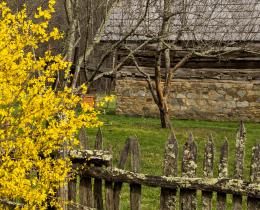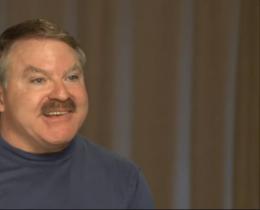I have been involved with the Omega Institute—a nonprofit, mission-driven, and donor-supported educational organization—in many capacities for many years. Its reach has captured my heart and held my attention. For more than 40 years Omega has been a leader in holistic studies—helping people and organizations integrate personal growth and social change, moving beyond “the way it is” toward “the way it can be.”
When Omega first moved to its current location, we were blessed with a fine facility that offered classrooms for teaching and housing facilities for our participants and some of our staff. We had a store that sold books, yoga materials, clothing, and many essentials, a spacious and welcoming dining hall, and a wellness center. What our new location did not offer, however, was a place reserved exclusively for meditation, prayer, and introspection. It would be essential, we realized, to create such a facility, and to be able to offer such a spiritual center to our participants and staff.
Conceiving the Sanctuary
I was serving as board chair at that time. I was passionate about many things associated with Omega—but two things in particular were paramount: one was the opportunity to develop a facility that would serve exclusively as a sanctuary for participants and staff, and second was identifying a project that would support Omega in its efforts to more fully develop a culture of philanthropy. We had the makings of a perfect synchronicity that favored the construction of a sanctuary on campus: it was a project that embodied the essence of Omega and it offered a loving and caring way to engage our participants and inspire in them their philanthropic inclination.
We formed a leadership group devoted to the success of the project. For two years, members of the leadership group regularly brought people on walks to the site where the Sanctuary would be built. We invited participants to join us in creating a circle, and asked them to offer a silent prayer that the Sanctuary be built with the best of intentions, that it serve the need of all those who visit, and that it be a place of serenity for people to either be alone or gather with others.
There is an expression that life is lived forward but understood backward. The notion of imbuing the site with prayers was part of the attention that was paid to all aspects of the Sanctuary’s development. Our goal was to introduce the concept of sanctuary to as many of our participants as we could. Their questions informed our answers. We learned a great deal from each visit. What we hadn’t anticipated was that the power of prayer would linger in the land, would be enveloped within the building structure, and would be manifest when you entered the Sanctuary to meditate.
We have since built many other facilities on campus—a retreat house for teachers who exchange dharma talks for retreat time, a library which now houses some 10,000 books that is named after one of our early and stalwart supporters, Ram Dass, and the Omega Center for Sustainable Living, an environmental center that is ecologically among the best in the world. But nothing prepared us for the benevolent power that exudes from the Sanctuary’s interior. It is palpable as you sit quietly, appreciating the silence, with nothing to do, nothing to say.
Opening With Prayers
When the Sanctuary officially opened, we held a private ceremony attended by the more than 200 people who helped in its development. We gave everybody a small slip of paper and asked them to write a note, wish, or prayer associated with the Sanctuary, a culmination of all the walks we had taken to the site before construction began and our intentions for the space. A single stone remained—once it was added, the wall would be complete. The space for that stone became the repository for all those slips of paper. We fit the last stone into place over the notes, forever preserving those prayers and wishes in the wall.
The Sanctuary can be accessed in two ways. The shorter path involves a steep climb up slate steps to the entrance of the building. The second path involves a more circuitous route from the base of the campus to the formal entrance, where you remove your shoes before entering.
One route is shorter and more athletic. The other is more contemplative and surrounded by woods. The choice is dictated by our availability. When we are rushed for time, we fit things in, often touching only the surface of an opportunity and foregoing the rich potential to settle down and settle in. Rushing is a disease that infects our very being. Even though it is quite contagious, it is hard to recognize.
When time is the controlling factor, we limit the depth of our experience. We’ll be back, we promise, and when we return we will bring no agenda with us other than a desire to melt into and be part of the peace that quiet provides. Occasionally we fulfill our promise and we return, eager to embrace the space provided within the Sanctuary. As we settle down and settle in, we expand into the fullness of who we are, whispering inside ourselves, “Welcome, welcome home.”
Finding a Safe Haven
Sanctuaries—often churches or other religious buildings—are places of refuge that are frequently referred to as the “Holy of Holies.” When sequestered in a Sanctuary, occupants were considered to be protected from attack and exposure. The space provided a refuge—a safe haven—from invasion and mayhem.
How often in life I have yearned for a Sanctuary where I could find respite from daily challenges—a place of refuge. Some find refuge by moving into an ashram or attending long retreats, while others visit churches hoping to connect with some power greater than themselves that will provide answers, offer a sign, or at the least listen to our plea to know, “Why me, why now?”
When I worked at Omega, the Sanctuary was the building I went to when I needed to separate myself from the daily demands of work. My issues would still be waiting patiently for me when I left the building, so I didn’t separate myself from the problems that needed to be addressed. But they were now coated with a universal energy that let me listen without prejudging, ask without expectation, and act without malice.
Sitting in the Sanctuary brought great comfort. My pace slowed, my mind quieted, my actions stilled. You could hear the silence and sense the calm within the room. There was no distraction. In Buddhism there is a breathing meditation in which you breathe in the evils of the world on the in-breath and on the out-breath you breathe out love. Whenever I sat in the Sanctuary, I reversed the process. I breathed in the energy of the Sanctuary and breathed out my troubles or my challenges or my failures, allowing them to be absorbed, diffused, and altered by the power in the room. When I left the Sanctuary, the challenges I entered with may not have been resolved, but they had been reduced in size and scope.
I carry that feeling with me every time I conjure up my memory of the Sanctuary. I now live in Oregon, so frequent trips to the Sanctuary are no longer possible. But when I do return, I sense that I am recharging a battery that has run down. The terrain is familiar, the interior an old friend, the quiet a blessing.
Making Your Own Refuge
I want this experience to be available to everyone, but am uncertain which approach would best accomplish this goal. The suggestion I offer below represents how I would explore finding personal sanctuaries. Build on this suggestion as you form your own sacred space.
Convert part of where you live into sacred space. It can be a room in a house or a corner of an apartment. Let your own prayers make this space become holy, your spiritual retreat, your grounding where you can find solace, strength, and renewal. Over time there will evolve a space that has been filled with your prayers and wishes. Add photographs, special letters, candles, poetry. Draw on personal items that have special meaning to you. In good times add more prayers and blessings to the space. In hard times, draw on the power of the space you have created to sustain you.



